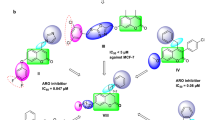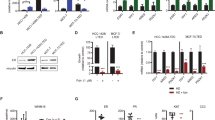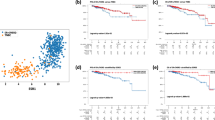Abstract
Tamoxifen, an important endocrine therapeutic agent, is widely used for the treatment of estrogen receptor positive (ER+) breast cancer. However, de novo or acquired resistance prevents patients from benefitting from endocrine approaches and necessitates alternative treatments. In this study, we report that small heat protein beta-8 (HSPB8) may serve as an important molecule in tamoxifen resistance. HSPB8 expression is enhanced in MCF-7 cells resistant to tamoxifen (MCF-7/R) compared to parent cells. Moreover, high expression of HSPB8 associates with poor prognosis in ER+ breast cancer patients but not in patients without classification. Stimulating ER signaling by heterogeneous expression of ERa or 17β-estradiol promotes HSPB8 expression and reduces the cell population in G1 phase. In contrast, blockage of ER signaling by tamoxifen down-regulates the expression of HSPB8. In addition, knocking down HSPB8 by specific siRNAs induces significant cell cycle arrest at G1 phase. AZD8055 was found to be more potent against the proliferation of MCF-7/R cells than that of parent cells, which was associated with down-regulation of HSPB8. We found that the anti-proliferative activity of AZD8055 was positively correlated with the HSPB8 expression level in ER+ breast cancer cells. Thus, AZD8055 was able to overcome tamoxifen resistance in breast cancer cells, and the expression of HSPB8 may predict the efficacy of AZD8055 in ER+ breast cancer. This hypothesis deserves further investigation.
Similar content being viewed by others
Log in or create a free account to read this content
Gain free access to this article, as well as selected content from this journal and more on nature.com
or
References
Siegel RL, Miller KD, Jemal A. Cancer Statistics, 2017. CA Cancer J Clin 2017; 67: 7–30.
Lobbezoo DJ, van Kampen RJ, Voogd AC, Dercksen MW, van den Berkmortel F, Smilde TJ, et al. Prognosis of metastatic breast cancer subtypes: the hormone receptor/HER2-positive subtype is associated with the most favorable outcome. Breast Cancer Res Treat 2013; 141: 507–14.
Lukong KE. Understanding breast cancer - The long and winding road. BBA Clin 2017; 7: 64–77.
Clarke R, Tyson JJ, Dixon JM. Endocrine resistance in breast cancer--An overview and update. Mol Cell Endocrinol 2015; 418: 220–34.
Milani A, Geuna E, Mittica G, Valabrega G. Overcoming endocrine resistance in metastatic breast cancer: Current evidence and future directions. World J Clin Oncol 2014; 5: 990–1001.
Chang M. Tamoxifen resistance in breast cancer. Biomol Ther (Seoul) 2012; 20: 256–67.
Ring A, Dowsett M. Mechanisms of tamoxifen resistance. Endocr Relat Cancer 2004; 11: 643–58.
Osborne CK, Schiff R. Mechanisms of endocrine resistance in breast cancer. Annu Rev Med 2011; 62: 233–47.
Gonzalez-Malerva L, Park J, Zou L, Hu Y, Moradpour Z, Pearlberg J, et al. High-throughput ectopic expression screen for tamoxifen resistance identifies an atypical kinase that blocks autophagy. Proc Natl Acad Sci U S A 2011; 108: 2058–63.
Chowdary TK, Raman B, Ramakrishna T, Rao CM. Mammalian Hsp22 is a heat-inducible small heat-shock protein with chaperone-like activity. Biochem J 2004; 381: 379–87.
Shemetov AA, Seit-Nebi AS, Gusev NB. Phosphorylation of human small heat shock protein HspB8 (Hsp22) by ERK1 protein kinase. Mol Cell Biochem 2011; 355: 47–55.
Carra S, Brunsting JF, Lambert H, Landry J, Kampinga HH. HspB8 participates in protein quality control by a non-chaperone-like mechanism that requires eIF2α phosphorylation. J Biol Chem 2009; 284: 5523–32.
Stebbing J, Filipovic A, Lit LC, Blighe K, Grothey A, Xu Y, et al. LMTK3 is implicated in endocrine resistance via multiple signaling pathways. Oncogene 2013; 32: 3371–80.
Ma XM, Blenis J. Molecular mechanisms of mTOR-mediated translational control. Nat Rev Mol Cell Biol 2009; 10: 307–18.
Shaw RJ, Cantley LC. Ras, PI3K and mTOR signalling controls tumour cell growth. Nature 2006; 441: 424–30.
Meng LH, Zheng XF. Toward rapamycin analog (rapalog)-based precision cancer therapy. Acta Pharmacol Sin 2015; 36: 1163–9.
Chresta CM, Davies BR, Hickson I, Harding T, Cosulich S, Critchlow SE, et al. AZD8055 is a potent, selective, and orally bioavailable ATP-competitive mammalian target of rapamycin kinase inhibitor with in vitro and in vivo antitumor activity. Cancer Res 2010; 70: 288–98.
Jordan NJ, Dutkowski CM, Barrow D, Mottram HJ, Hutcheson IR, Nicholson RI, et al. Impact of dual mTORC1/2 mTOR kinase inhibitor AZD8055 on acquired endocrine resistance in breast cancer in vitro. Breast Cancer Res 2014; 16: R12.
Li T, Wang J, Wang X, Yang N, Chen SM, Tong LJ, et al. WJD008, a dual phosphatidylinositol 3-kinase (PI3K)/mammalian target of rapamycin inhibitor, prevents PI3K signaling and inhibits the proliferation of transformed cells with oncogenic PI3K mutant. J Pharmacol Exp Ther 2010; 334: 830–8.
Chen SM, Liu JL, Wang X, Liang C, Ding J, Meng LH. Inhibition of tumor cell growth, proliferation and migration by X-387, a novel active-site inhibitor of mTOR. Biochem Pharmacol 2012; 83: 1183–94.
Li XS, Xu Q, Fu XY, Luo WS. Heat shock protein 22 overexpression is associated with the progression and prognosis in gastric cancer. J Cancer Res Clin Oncol 2014; 140: 1305–13.
Shankavaram UT, Varma S, Kane D, Sunshine M, Chary KK, Reinhold WC, et al. CellMiner: a relational database and query tool for the NCI-60 cancer cell lines. BMC Genomics 2009; 10: 277.
Behrens D, Lykkesfeldt AE, Fichtner I. The mTOR pathway inhibitor RAD001 (everolimus) is highly efficacious in tamoxifen-sensitive and -resistant breast cancer xenografts. Target Oncol 2007; 2: 135–44.
Bachelot T, Bourgier C, Cropet C, Ray-Coquard I, Ferrero JM, Freyer G, et al. Randomized phase II trial of everolimus in combination with tamoxifen in patients with hormone receptor-positive, human epidermal growth factor receptor 2-negative metastatic breast cancer with prior exposure to aromatase inhibitors: a GINECO study. J Clin Oncol 2012; 30: 2718–24.
Naing A, Aghajanian C, Raymond E, Olmos D, Schwartz G, Oelmann E, et al. Safety, tolerability, pharmacokinetics and pharmacodynamics of AZD8055 in advanced solid tumours and lymphoma. Br J Cancer 2012; 107: 1093–9.
Hong B, Wang H, Deng K, Wang W, Dai H, Lui VWY, et al. Combination treatment of RAD001 and BEZ235 exhibits synergistic antitumor activity via down-regulation of p-4E-BP1/Mcl-1 in small cell lung cancer. Oncotarget 2017; 8: 106486–98.
Fan QW, Nicolaides TP, Weiss WA. Inhibiting 4EBP1 in glioblastoma. Clin Cancer Res 2018; 24: 14–21.
Acknowledgements
We thank Associate Professor Xiang WANG and Mr Yu-xiang WANG for their help with the cell culture and suggestions for the experimental design. This work was supported by the National Natural Science Foundation of China (81373445) and "Personalized Medicines-Molecular Signature-based Drug Discovery and Development", Strategic Priority Research Program of the Chinese Academy of Sciences (XDA12020202).
Author information
Authors and Affiliations
Corresponding authors
Electronic supplementary material
Supplementary Figure S1
Growth inhibition of tamoxifen alone or tamoxifen +AZD8055 in MCF-7/R cells.
Supplementary Figure S2
Anti-proliferative activity of tamoxifen in MCF-7/R cells with down-regulated HSPB8.
Rights and permissions
About this article
Cite this article
Shi, Jj., Chen, Sm., Guo, Cl. et al. The mTOR inhibitor AZD8055 overcomes tamoxifen resistance in breast cancer cells by down-regulating HSPB8. Acta Pharmacol Sin 39, 1338–1346 (2018). https://doi.org/10.1038/aps.2017.181
Received:
Accepted:
Published:
Issue date:
DOI: https://doi.org/10.1038/aps.2017.181
Keywords
This article is cited by
-
Integrative analysis of single-cell and transcriptome sequencing with experimental validation reveals PKHD1L1 as a novel biomarker in lung adenocarcinoma
Scientific Reports (2025)
-
Identification of Alternatively Spliced Novel Isoforms of Human HSPB8 Gene
The Protein Journal (2024)
-
Targeting PI3Kα overcomes resistance to KRasG12C inhibitors mediated by activation of EGFR and/or IGF1R
Acta Pharmacologica Sinica (2023)
-
Targeting the PI3K/AKT/mTOR and RAF/MEK/ERK pathways for cancer therapy
Molecular Biomedicine (2022)
-
HSPB8 counteracts tumor activity of BRAF- and NRAS-mutant melanoma cells by modulation of RAS-prenylation and autophagy
Cell Death & Disease (2022)



